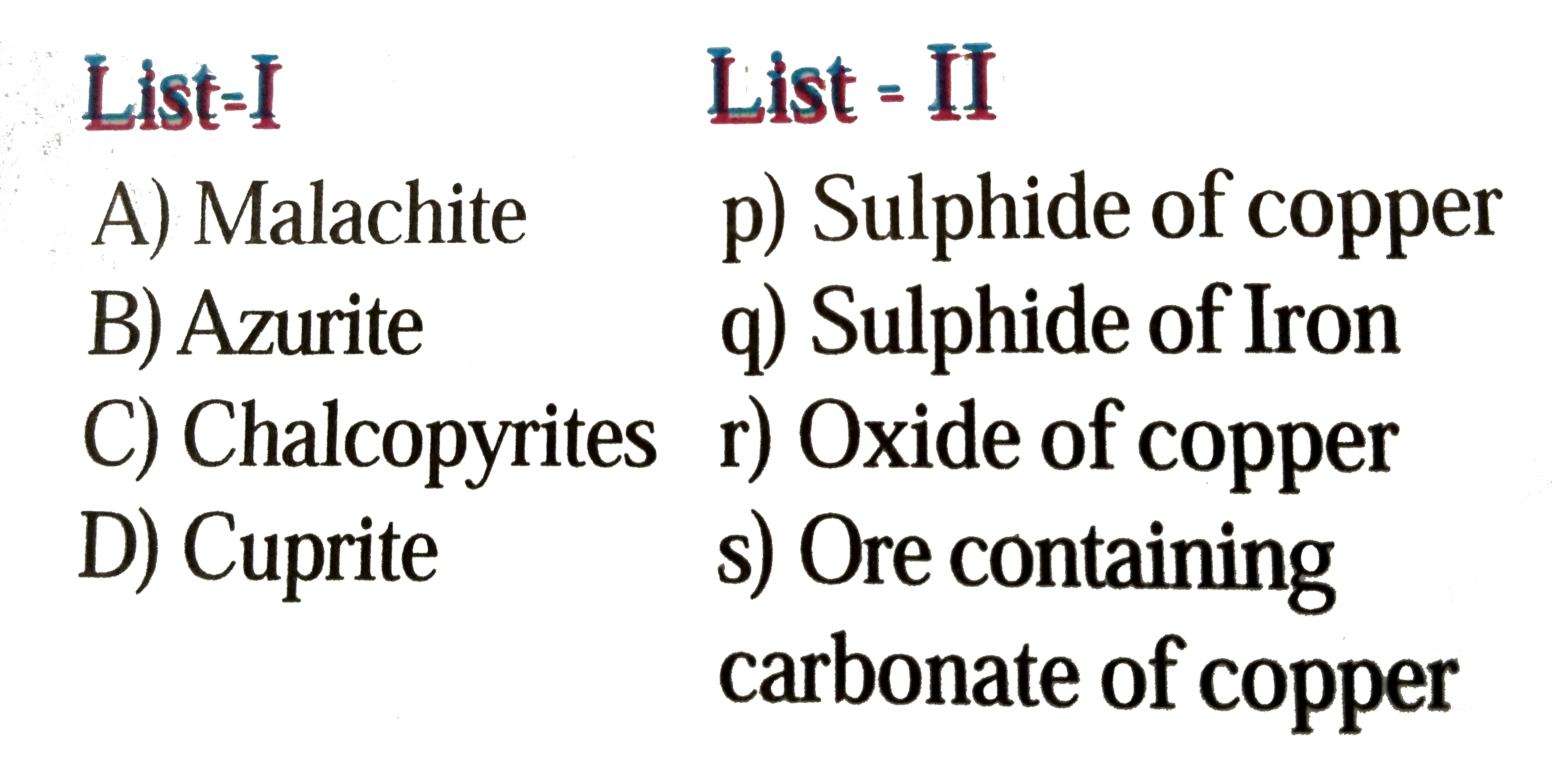Match the following
List-I (ore)List-II(Metal)(1)Malachite(a)Cu(2)Siderite(b)Zn(3)Sphalerite(c)Fe(4)Kaolinite(d)AlSolution in Telugu
1234bcad
1234dbca
1234abcd
1234cadb
The correct Answer is:B
Step by step video, text & image solution for Match the following {:("List-I (ore)","List-II(Metal)"),((1)"Malachite",(a)Cu),((2)"Siderite",(b)Zn),((3)"Sphalerite",(c)Fe),((4)"Kaolinite",(d)Al):} by Chemistry experts to help you in doubts & scoring excellent marks in Class 12 exams.
Updated on:21/07/2023Topper's Solved these Questions
- METALLURGYBOOK - AAKASH SERIESCHAPTER - METALLURGYEXERCISE - LEVEL-II (LECTRURE SHEET) (EXERCISE-I)
43 Videos
- METALLURGYBOOK - AAKASH SERIESCHAPTER - METALLURGYEXERCISE - LEVEL-II (LECTRURE SHEET) (EXERCISE-II) (PASSAGE-I)
5 Videos
- IONIC EQUILLIBRIUMBOOK - AAKASH SERIESCHAPTER - IONIC EQUILLIBRIUMEXERCISE - ADDITIONAL PRACTICE EXERCISE (PRACTICE SHEET ( ADVANCED))
11 Videos
- NITROGEN CONTAINING COMPOUNDSBOOK - AAKASH SERIESCHAPTER - NITROGEN CONTAINING COMPOUNDSEXERCISE - Conversions
18 Videos
Similar Questions
Which of the following ores is/are oxide ones)?
View SolutionElectrolysis is an important technique for extraction of metals and each low of the solution needs a minimum voltage to get discharged and this value is expressed in terms of discharge potential. For some metal ions the discharge potentials follow the order give below :
Li+>K+>Ca2+>Na+>Mg2+>Al3+>Zn2+>Fe2+>Ni2+>H3O+>Cu2+>Hg2+2>Ag+>Au3+ For some anions the discharge potentials are in the order:
SO2−4>NO−3>OH−>Br−>I−
When aqueous solution of cuprous bromide is electrolysed the product obtained a cathode will be
View SolutionA solution contains 0.05M of each of NaCl and Na2,CrO4,. Solid AgNO3, is gradually added to it. Whichof the following facts true
(Given: Ksp(AgCl)=1.7×106(−10)M2 and Ksp(Ag2,CrO4,)=1.9×10−12M3:
View SolutionEthanamine to methanamine
View SolutionMatch the ores of List-I with their composition in List-II
View SolutionMatch the ores of List-I with their composition in List-II

View SolutionMatch the ores (column A) with the metals (column B) : {:("(""column " A")" ,,, "(""column " B")") , ("Ores" ,,, "Metals"), ((I) , "Siderite" , (a) , "Zinc"), ((II) ,"Kaolinite" , (b) , "Copper"), ((III) ,"Malachite" , (c) , "Iron "), ((IV) ,"Calamine" , (d) , "Aluminium"):}
View SolutionMatch the List-I with List-II {:(,"List-I (Electrode)",,"List -II (Type)"),(1,"Calomel",(A),"Reference"),(2,"Glass",(B),"Redox"),(3,"Hydrogen",(C),"Membrane"),(4,"Quinhydrone",(D),"Gas"),(,,,):}
View SolutionMatch the following from column I to column II
Column IColumn IIMalachiteFeSphaleriteAgHorn silverZnChromineCu
View Solution(1) Kaolinite is an ore of Al. (2) Sphalerite is an ore of sulphide of Cu. (3) Malachite is an oxide ore of copper (4) Sphalerite is an iron carbonate.
View SolutionMatch the ores of List - I with their composition in List - II
List - IList - II(P)Malachite(1)Sulphide of copper(Q)Azurite(2)Sulphide of iron(R)Chalcopyrites(3)Dirty brown(S)Cuprite(4)Ore containing carbonate of copper
View Solutionनिम्नलिखित धातुओं के मुख्य अयस्कों को उनके सूत्रों सहित लिखिए :
(i) Al (ii) Fe (iii) Cu (iv) Zn
View SolutionMatch the following
List-I (Type of mineral)List-II(1)Oxide(a)Kaolinite(2)Carbonate(b)Calamine(3)Sulphide(c)Copper glance(4)Silicate(d)Cuprite
View SolutionMatch the ores (column A) with the metals (column B) :
(column A)(column B)OresMetals(I)Siderite(a)Zinc(II)Kaolinite(b)Copper(III)Malachite(c)Iron (IV)Calamine(d)Aluminium
View SolutionSphalerite and siderite are the ores of the metals
View Solution
